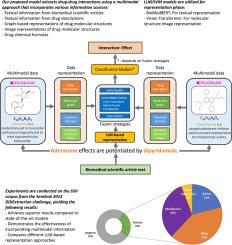融合策略提取药物-药物相互作用的多方面方法。
IF 4.5
2区 医学
Q2 COMPUTER SCIENCE, INTERDISCIPLINARY APPLICATIONS
引用次数: 0
摘要
目的:当一种药物影响另一种药物的疗效时,就会发生药物-药物相互作用(ddi),可能导致不可预见的患者预后。现有的研究主要集中在文本数据上,但忽视了药物的丰富的多模态信息。本研究旨在通过整合多种数据模式和评估各种融合策略来增强DDI提取。方法:我们引入了一种多模态方法,该方法集成了药物信息的不同表示(科学文本、图表、公式、图像和描述),以增强对药物-药物相互作用的检测。我们探索了各种融合技术,以便在早期、中期和晚期融合阶段有效地结合这些模式。此外,我们确定了导致失败案例的因素,提供了对模型局限性和潜在改进的见解。我们使用公开可用的DDI数据集进行了实验,与现有方法相比,证明了显著的改进。结果:该模型在DDI检测方面明显优于现有方法。中间融合策略,特别是预测级连接,显示出优越的准确性和鲁棒性。详细分析确定了导致失败案例的因素,为未来的改进提供了见解。结论:研究结果强调了多模态融合在提高预测准确性方面的潜力,为更安全的药物治疗和更明智的临床决策提供了基础。本文章由计算机程序翻译,如有差异,请以英文原文为准。

A multifaceted approach to drug–drug interaction extraction with fusion strategies
Objective:
Drug–drug interactions (DDIs) occur when one medication affects the efficacy of another, potentially leading to unforeseen patient outcomes. Existing studies primarily focus on textual data, but overlook a wealth of the drug’s multimodal information. This study aims to enhance DDI extraction by integrating diverse data modalities and evaluating various fusion strategies.
Methods:
We introduce a multimodal approach that integrates diverse representations of drug information (scientific text, graphs, formulas, images, and descriptions) to enhance the detection of drug–drug interactions. We explored various fusion techniques to effectively combine these modalities across early, intermediate, and late fusion phases. Additionally, we identify the factors contributing to failed cases, providing insights into the model’s limitations and potential improvements. We have conducted experiments using publicly available DDI datasets, demonstrating significant improvements compared to existing methods.
Results
: The proposed model significantly outperformed existing methods in DDI detection. Intermediate fusion strategies, particularly prediction-level concatenation, demonstrated superior accuracy and robustness. Detailed analyses identified factors contributing to failed cases, offering insights for future improvements.
Conclusion:
The findings highlight the potential of multimodal fusion to enhance predictive accuracy, providing a foundation for safer drug therapies and better-informed clinical decisions.
求助全文
通过发布文献求助,成功后即可免费获取论文全文。
去求助
来源期刊

Journal of Biomedical Informatics
医学-计算机:跨学科应用
CiteScore
8.90
自引率
6.70%
发文量
243
审稿时长
32 days
期刊介绍:
The Journal of Biomedical Informatics reflects a commitment to high-quality original research papers, reviews, and commentaries in the area of biomedical informatics methodology. Although we publish articles motivated by applications in the biomedical sciences (for example, clinical medicine, health care, population health, and translational bioinformatics), the journal emphasizes reports of new methodologies and techniques that have general applicability and that form the basis for the evolving science of biomedical informatics. Articles on medical devices; evaluations of implemented systems (including clinical trials of information technologies); or papers that provide insight into a biological process, a specific disease, or treatment options would generally be more suitable for publication in other venues. Papers on applications of signal processing and image analysis are often more suitable for biomedical engineering journals or other informatics journals, although we do publish papers that emphasize the information management and knowledge representation/modeling issues that arise in the storage and use of biological signals and images. System descriptions are welcome if they illustrate and substantiate the underlying methodology that is the principal focus of the report and an effort is made to address the generalizability and/or range of application of that methodology. Note also that, given the international nature of JBI, papers that deal with specific languages other than English, or with country-specific health systems or approaches, are acceptable for JBI only if they offer generalizable lessons that are relevant to the broad JBI readership, regardless of their country, language, culture, or health system.
 求助内容:
求助内容: 应助结果提醒方式:
应助结果提醒方式:


